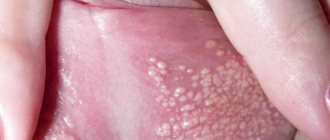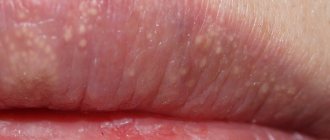Bartholinitis is an inflammation of the Bartholin gland (large gland of the vestibule), which is located at the entrance to the vagina, near the labia minora. The Bartholin gland is essential for moisturizing the vaginal wall. If its excretory duct is blocked, then either a cyst or an abscess is formed.
- A Bartholin gland cyst is filled with sterile fluid and often causes no symptoms.
- An abscess is a painful, inflamed collection of pus.
An abscess is called bartholinitis. Sometimes the cyst also becomes inflamed, in which case it is rightly called bartholinitis.
Our expert in this field:
Alimardonov Murad Bekmurotovich
Gynecologist-oncologist, Ph.D.
Call the doctor Reviews about the doctor
Causes of Fordyce granules
This is a light rash that can form on the lips, cheeks, genitals and groin area, on the chest, oral mucosa, and other places. At the moment they are not considered a pathology, but sometimes cause discomfort. Another name for granules is seborrheic cysts. They are not transmitted by contact and are more of an aesthetic defect.
Most often, their occurrence occurs during puberty, when hormonal changes occur in the body. It is believed that the formation of these white pimples on the lips may be due to the close location of the sebaceous glands to the surface of the skin.
There are the following reasons for the appearance of white pimples on the lip:
- smoking;
- abnormal location of the sebaceous glands;
- improper care;
- hormonal disorders;
- narrowing of the excretory canals of the sebaceous glands.
This rash may resolve on its own.
Where are the Bartholin glands located?
The Bartholin's glands are a pair of pea-sized glands that are found behind and on either side of the lips that surround the opening of the vagina. The ducts that carry the fluids produced by the gland are approximately 2.5 cm long, and their outlets through which mucus is secreted are 0.5 cm in diameter. The fluid passes through these tiny tubes into the vagina to moisturize the labial (external) opening of the vagina , making contact with this sensitive area of the female intimate place more comfortable and enjoyable.
To make it easier to anatomically identify the glandular openings and visualize where they are located, think of the vulva as a clockwork mechanism. So, the outlets are located at 16 and 20 o'clock on the conventional dial. Under normal conditions, Bartholin's glands are small and usually not visible or palpable because... are soft and elastic in structure and rarely exceed 1 cm in diameter.
Photo No. 1. “Where are a woman’s Bartholin glands located?”
How do they work
At the moment of sexual arousal, the glands in the vagina produce a mucous secretion, which is necessary to reduce the likelihood of injury to the genital organs during intimacy. A small amount of it is released in a calm state, due to which women do not feel tightness, dryness in the vagina and other unpleasant sensations. By pressing on the gland and duct, you can get a small amount of secretion. The sebaceous glands of the vulva secrete sebum, which lubricates the hair, and the sweat glands, in turn, secrete sweat, which gives the vulva a specific odor.
The functions of the Bartholin glands are controlled by the female hormones estrogen, so they are most active during the reproductive period. During menopause, when the level of estrogen in the body drops sharply, the Bartholin glands practically do not secrete fluid.
Diagnostics
It is necessary to check the health and functioning of the Bartholin gland if a girl has complaints of pain and other unpleasant sensations in the intimate area.
They are also assessed during a preventive examination by a gynecologist. Basic examination methods:
- visual inspection,
- palpation.
- secretion analysis (smear, PCR, bacterial culture, oncocytology),
- ultrasonography.
What to do if there are pimples on your lips?
Unlike other areas, white pimples on the lips are usually smaller, about 2 mm in diameter, and less prominent. In some cases, they may itch, but you should scratch them as they can become infected. You cannot squeeze them out, as this can cause microtraumas and scars.
It is necessary to consult a doctor who will make the correct diagnosis and prescribe treatment. It may turn out that the rash on the lips is a completely different disease, for example, herpes or acne.
Diseases of the Bartholin glands
Causes of inflammatory processes and risk factors for the development of other pathologies:
- Failure to comply with personal hygiene rules (especially during menstruation).
- Any local microtraumas (scratching, epilation of deep bikini, sexual intercourse with dry vulva).
- Wearing tight underwear.
- Too active sex life, ignoring barrier contraception.
- The presence of foci of persistent infection in the body (caries, pyelonephritis).
- Impaired functioning of the immune system, lack of vitamins.
- Surgical interventions on the genitourinary area (for example, abortion).
Pathologies of this place occur, first of all, when the exit of one or both ducts is blocked, which prevents the release of mucus to the outside with the development of inflammation - bartholinitis. These cases are often associated with sexually transmitted infections (STIs) or other bacterial pathogens such as E. coli and enterococci. Bacteria that normally inhabit our skin, such as staphylococci and streptococci, may also be a cause. Other risk factors include hypothermia, the presence of foci of chronic infection in the body (adnexitis, tonsillitis, caries, etc.).
The two most common complications arising from this problem are cyst and gland abscess.
Benign and malignant tumors of this location are very rare and account for approximately 1% of all vulvar tumors. But they still exist for this reason - after all, the gland consists of columnar epithelium, and the ducts are lined with multilayered squamous epithelium and transitional cell epithelium. Therefore, adenocarcinomas, squamous cell carcinoma and, less commonly, transitional cell carcinoma can arise from the Bartholin gland in women. Most primary adenocarcinomas of the vulva arise in these glands.
The average age at diagnosis is 55-57 years. 10-15% of patients had a history of inflammation of Bartholin's gland. Human papillomavirus (HPV in women) has been identified as a major contributor to the development of squamous cell carcinoma of this organ.
Is it possible for acne to appear on the lips?
Acne is a disease of the sebaceous glands. Since there are very few of them on the red border of the lips, the likelihood of acne forming in this area is low. But acne can form in the area around the lips. If a dermatologist has diagnosed acne, he may prescribe azelaic acid preparations for treatment9. Azelik® belongs to this group of drugs. This is a 15% azelaic acid gel with the following properties5:
- the ability to normalize keratinization processes in follicles;
- anti-inflammatory effect exerted by reducing the metabolism of neutrophils and the free radical forms of oxygen they produce;
- reduction of free fatty acids in skin lipids;
- antimicrobial activity against propionibacteria and Staphylococcus epidermidis.
The results from the action of Azelik®, as a rule, become noticeable after 4 weeks of using the drug5.
Symptoms of bartholinitis
- acute, sudden pain in the labia area, intensifying during sex, sitting, walking;
- at the entrance to the vagina you can feel a sensitive, sometimes hot formation;
- heat.
However, sometimes there are no symptoms with bartholinitis.
To diagnose bartholinitis, the doctor just needs to ask the patient about the symptoms and conduct an examination.
Treatment of bartholinitis
Sometimes the abscess breaks out on its own. Then the woman is prescribed painkillers, warm compresses or sitz baths.
In other cases, the priority method of treating bartholinitis is incision and drainage. Under local anesthesia, the doctor makes a small incision and allows the pus to drain.
It is still unclear what reliably increases the risk of developing bartholinitis, so there are no good methods for its prevention. The only thing that can be done is to protect yourself from sexually transmitted diseases: there are studies that show a connection between STDs and the occurrence of bartholinitis. It is also known that the Bartholin gland becomes inflamed only in women of reproductive age. Up until menopause, the risks increase and then decrease. If a woman has already had bartholinitis, then she is more likely to develop a new abscess.
Ward catheter
If the abscess occurs for the first time or for the second time, a Ward catheter is usually inserted. This is a short flexible tube with an inflatable balloon at the end. The ball is placed in the abscess cavity after drainage, then salt water is poured into it and left for a month. After this time, the gynecologist removes the catheter (the process does not require anesthesia). This approach promotes normal healing and reduces the risk of recurrence to 2 to 18 percent. However, an important contraindication for the use of this method is an allergy to latex.
If a relapse occurs after using the Ward catheter, it is recommended to perform marsupialization. It is needed, in fact, for the formation of a new excretory duct of the Bartholin gland.
We will call you back, leave your phone number
Message sent!
expect a call, we will contact you shortly
Marsupialization
This procedure is performed under anesthesia, sometimes general. During marsupialization, a fairly large incision is made first in the epithelial tissue, and then in the excretory duct hidden underneath it, in which an abscess has formed. After the pus is drained, these tissues are sutured together so that the abscess cavity remains open. Then it is washed. This procedure takes longer, but it causes less discomfort in patients in the future (although it requires cessation of sexual activity for 2-4 weeks). Relapses occur in 2–13 percent of cases.
When this does not help, the tissue is treated with silver nitrate: first a small incision is made, after the pus has drained, silver nitrate is placed into the cavity and the incision is sutured or covered with a bandage. After 2–3 days, the dead tissue falls off or is removed by a surgeon. But this procedure is very unpleasant for patients (complications: swelling of the labia, pain, heavy discharge, hemorrhage in the tissues), moreover, it often causes scars to form.
Laser therapy
Laser vaporization is also used to cut or remove an abscess. However, in this case, special equipment and an experienced specialist are required. It should also be said that laser vaporization is more expensive than other treatment methods.
Removal and drug therapy
In extreme cases, the Bartholin gland is removed. They do this only in a difficult situation, because this method has a high risk of complications: severe bleeding, hematoma, inflammation, scar formation and - rarely - pain during sex. After removal of the Bartholin's gland, a woman must spend several days in the hospital.
Antibiotics have not been shown to be effective when prescribed to all women with bartholinitis. Therefore, they are recommended to be used:
- if there is an increased risk of spreading the infection (for example, pregnant women and women with severe immunodeficiency);
- if abscesses occur again and again;
- if after drainage the analysis showed that the infection is caused by methicillin-resistant Staphylococcus aureus;
- if there are signs of systemic infection (eg fever);
- if a woman has been diagnosed with chlamydia or gonorrhea.










